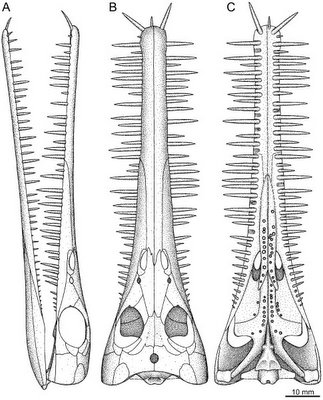Mesosaurus tenuidens

The cranial skeleton of the Early Permian aquatic reptile Mesosaurus tenuidens: implications for relationships and palaeobiology
SEAN PATRICK MODESTO Zoological Journal of the Linnean Society Volume 146 Issue 3 Page 345–368 - March 2006
The cranial osteology of the aquatic reptile Mesosaurus tenuidens is redescribed on the basis of new and previously examined materials from the Lower Permian of both southern Africa and South America.
Mesosaurus is distinguished from other mesosaurs in exhibiting an absolutely larger skull and possessing relatively longer marginal teeth. The teeth gradually angle outwards as one progresses anteriorly in the tooth row and become conspicuously procumbent at the tip of the snout. The suggestion that mesosaurs used their conspicuous dental apparatus as a straining device for filter feeding is based upon erroneous reconstruction of a high number of teeth in this mesosaur. Reinterpretation of the morphology and the organization of the marginal teeth of Mesosaurus suggests that they were used to capture individually small, nektonic prey. General morphological aspects of the skull support the idea that Mesosaurus
was an aquatic predator and that the skull was well adapted for feeding in an aqueous environment. The anatomical review permits critical reappraisal of several cranial characters that have appeared in recent phylogenetic analyses of early amniotes. Emendation of problematic characters and reanalysis of amniote phylogeny using a slightly modified data matrix from the literature strengthens the hypothesis that mesosaurs form a clade with millerettids, procolophonoids and pareiasaurs within Reptilia.













<< Home